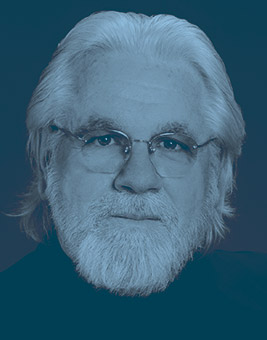
Mindful Leadership and the Wisdom of “Seeing Clearly”
A Q&A with Fortune 50 Business Consultant and Mindfulness Adviser Michael Carroll
Leading a business is a daunting, unrelenting proposition. Big (and little) decisions, constant fires, personnel issues, only a half cup of coffee left in the pot, your conferencing system going down right in the middle of a big client meeting. Occupying the C-Suite seems to be the antithesis to calm, quiet reflection.

Michael Carroll
As a former senior executive for global corporations like Disney, Shearson-Lehman/American Express, Simon & Schuster and Paine Webber, Michael Carroll has learned that creating a vision, requires just that – time for calm, quiet reflection. Today, as COO of Global Coaching Alliance, author of The Mindful Leader and an authorized teacher of Buddhist meditation practices, Carroll helps leaders solve this apparent conflict. We recently spoke with Carroll about bridging this gap between thoughtful leadership and the realities of running a business.
Quotes have been lightly edited for clarity
How do we train our minds to skillfully engage the many dynamics of change?
Carroll: When it comes to engaging change, we typically seek a way forward that’s reliable, predictable and even familiar — and these are all very good things. In certain circumstances, having no surprises is very important.
But when we step back, particularly in industries like healthcare that are going through such rapid change, seeking stability, familiarity and predictability during change can be as blinding as it is clarifying. There is a forward-looking intent to pursuing predictability and clear goals that may blind us to the very resources, relationships, opportunities needed to achieve our goals.
Part of the approach to mindful leadership is training the mind to see clearly in the midst of change and ambiguity and to be curious about what can be overlooked. It’s one thing to tell yourself that ambiguity is a friend. It’s another to feel like it’s a friend.
How does mindfulness allow you to do that?
Mindfulness is very simple. Basically, it’s training our attention – that so often seems caught up in rehearsing our lives inside our head – to seeing clearly where we are. Essentially, we’re training ourselves to distinguish between a “thought” and an “experience” – to not be trapped by our own mindset and to access an ease of perception, curiosity, and perspective. Over time as we practice mindfulness consistently, this flexibility becomes stronger and stronger, offering an emotional and intellectual clarity – a kind of spiritual agility – that we use to engage change without getting trapped by our hopes and fears.
This isn’t to say that some amount of stability and predictability isn’t helpful during times of change. Rather, mindfulness offers us the possibility of being confident in-between familiarity and the unknown – knowing they both provide an important dynamic to managing disruption and change.
In terms of setting a vision, that seems right on target for the mindset you would need.
Yes. I grew up on Wall Street in the 80’s. I remember a tough-minded executive would often remind us: “If you don’t know where you’re going, you’re lost. If you don’t have clear goals, then you’re lost.” That was something people said all the time, and I remember thinking that is a tricky definition of being lost. I mean, goals are important of course.
But when it comes to being lost, it’s not so much not knowing where you are going – being lost is not knowing where you are. That’s what mindfulness awareness is about. It’s being very comfortable, open, clear and in touch with the dynamics you’re seeking to engage as you pursue a goal. That is the definition of not being lost.
Traditionally we set visions, goals and perspectives. If we get from Point A to Point B and achieve our vision at point B, we consider that success. That’s no longer a very skillful approach to considering vision. Because if we look carefully, what happens along the way of getting to point B often disrupts that vision significantly.
Healthcare is highly regulated, and organizations are heavily invested in the current reality. Isn’t a flexible mindset difficult in that kind of environment?
In healthcare, with growing demands being placed on hospitals, doctors, insurance companies, etc., the people shouldering those challenges can experience such growing demands as risks, annoyances and at times even threats. There are threats to income and demands on people’s time, like doctors and nurses spending more time with computers than patients. There are threats to one’s authority and challenges to the accepted way of doing things. And unfortunately, feeling under siege is often the result – resisting challenges, trying to protect ourselves and burning out.
This is where the mindfulness comes in, where we can train ourselves to be curious about change rather than threatened by it; to stop amplifying stress and begin managing it; to be agile in the face of change rather than stuck. But mindfulness meditation doesn’t make problems disappear.
I would also suggest that cultivating a flexible mindset requires that we form healthy alliances with really smart experts.
We all know the score: our bottom line is getting squeezed, quality control is starting to throttle us, system upgrade costs are ballooning – we could go on and on – and we feel like, “Oh my God, working with someone who can create a perspective and help us see all of these dynamics differently is most likely not going to happen within my institution. It’s somewhere else.” Being able to go out and get good advice, helps the executive stick his or her head up above the dynamic that can feel so pressured.
Is that expert advice strictly for functional or technical elements or is it about personal perspective?
It’s both, of course.
It’s important to help our employees train their minds to be more mindful and fully present – to manage stress more agilely, to explore change rather than resist it. But such training doesn’t make the problems disappear. It does equip us to maneuver better and build healthy alliances with people – both internal and external – who can help us with functional and technical challenges – to help us negotiate, communicate, evaluate, execute and much more.
Part of the task for a leader is conceiving a vision. But then there’s also the task of getting behind the vision and getting an organization to follow you. How should leaders manage that?
When a leader presents a vision to an organization, an enterprise, a group of people or a team, those who are receiving that presentation must recognize their fingerprints on that vision. They should feel that they have authored that vision to some degree. That means that you have built the vision from the ground up. It really does start off with understanding what everybody is going through.
Too often, vision is driven by spreadsheets, competitive analysis, product plans, service planning, and marketing. All those are important, of course. But relying on those views too much can come back and bite you if you haven’t spent time feeling your sales rep’s pain, exploring your warehouse and fulfillment problems; listening to your vendors, customers and patients. What are people going through? What do they have to say? What would make their life better? The question for the visionary leader is: do all my stakeholders recognize themselves in my vision? Are they included?
If you’re a CEO you’re probably a type-A, hard-driving, take-command type of person. What does it take to conceive a vision and then gain buy-in?
On the hard-charging thing: I get it. You’ve got to work hard. Particularly if you’re doing a turnaround, or you’re in a particularly rigid culture with a lot of entrenched interests that resist change.
Often, however, the phrase “type-A & hard charging” is camouflage for not paying attention where a leader gives him or herself permission to disregard messages that are coming toward him or her — to speed past situations rather than truly appreciate them. Too often “Type-A, hard chargers” are trying to get from point A to point B as quickly as possible and as productively as possible. I get it.
Urgency, focus, playing hardball, negotiating tough, competing, being legally compliant, I have no problem with that. But for mindful leaders, we want to make sure that when we arrive at point B, our collective sanity is intact. Our divorce rate, we don’t want that up. Our addiction to drugs, you don’t want that up. Our customer quality and customer loyalty – we don’t want those to go down.
The hard part I don’t mind. It’s the charging part I have a problem with – “charging” past our experience on our way to success can create a lot of unnecessary problems and mindfulness can help avoid those mistakes.
